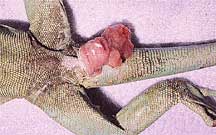Lizard Cloacal Prolapse
| This article is still under construction. |
Cloacal prolapse is a common problem in lizards; it is usually secondary to an infective process or straining due to dystocia or constipation.
The clinical signs in a male lizard are usually one or both of the hemipenes prolapsed; in females, they usually include a partial prolapse of the oviduct, if complete usually severely traumatised.
- Diagnosis - History, physical examination, microscopy, culture and sensitivity.
- Treatment depends on the severity of the case:
- Mildly traumatised cases:
- Gently cleanse exposed tissues
- Apply local antibiotics
- Lubricate and replace
- Severely traumatised cases:
- Amputation under general anaesthesia
Amputation of hemipene: Place one or more mattress sutures through viable tissue proximal to proposed point of amputation. After excision allow ligated stump to retract into hemipenal pockets. Parenteral antibiotics are advised.
Amputation of oviduct: ovariosalpingectomy (see Lizard and Snake Dystocia)
